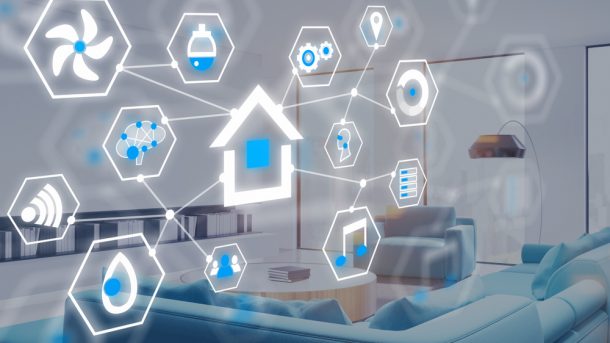Couches that can transform into beds were an innovation loved by all minimalistic designers, and large furniture companies quickly joined the trend, with ‘hacks’ to living smart, saving people time, money, and space in their homes.
As the movement progressed, ‘smart’ transformed into a different definition, reflecting the use of technology to enhance day-to-day activities, and hence, the revolution of smart cities, smart furniture, smart devices, smart cars, and alas, smart living, ignited.
As governments work towards transforming their cities and countries into ‘smart’ communities, with the emergence of 5G, real estate technology and the Internet of Things, it becomes imperative to discuss what smart living means for people.
In fact, a recent report from the World Economic Forum and Accenture found that the Internet of Things (IoT) will add $14 trillion to the global economy by 2030. [1]
What is smart living?
Although smart living can be an umbrella term for all smart products and shortcuts in day-to-day living, it is often used to describe smart homes.
Have you ever forgotten the stove on and had to drive your car back to keep your home from setting on fire? This may sound a little over the edge, but the reality is not far away for many people – and while most of us can forget the lights on and regret it by the end of the month as the electricity bill racks up, people who live in smart homes don’t take part in this hassle.
While clapping to turn the lights on and off are an outdated innovation, smart living goes beyond that. Living in a smart home stems out across all your devices, thanks to the Internet of Things, which allows your devices to interact with each other for seamless living and convenience.
A look into smart living
It’s early in the morning. Your curtains slowly begin to open to help you wake up at your natural cycle, then your alarm rings, signaling your coffee to start brewing espresso because your mattress can sense you didn’t sleep well last night.
You finally get up, and you get into the shower. As soon as you’re out, your room warms up and you choose an outfit recommended to you by your closet based on the weather forecast and your tired mood, which your wardrobe knows because you didn’t sleep very well.
There’s more. You get downstairs, you pick up your coffee and begin prepping cornflakes for your daughter, because your fridge reminded you to get some milk last night, which was running out. Your fridge recommends you to begin prepping that chicken you forgot was in, so you start, and once you’re done, you notice it’s time to leave.
Your car has already turned on, and begun air-conditioning five minutes prior, and as soon as you’re out the door, everything turns off – your lights, your TV, and anything else aside from the fridge, of course.
This is smart living, and it is not the future: many are living alongside machines that understand them, and are experiencing a hyper-personalized lifestyle that humanity has never witnessed before.
Are people actually living smart?
According to PwC’s report on smart homes, Gartner Research projects that there will be around 20.8 billion IoT-enabled devices globally by 2020, while IDC forecasts that the global IoT market will reach $1.7 trillion. [2]
Despite this, 77% of people in the UK do not own any smart device as per a YouGov paper. [3] The report discovered that as of 2018 in the UK:
- Over one in every ten adults own a smart speaker
- 1.7 million households own smart thermostats
- 5% own smart lighting
- 3% own smart security systems
While most people are aware of smart devices, such as voice-assistants, most have not made the switch yet to a full smart living experience. Despite this, the transformation is occurring quickly, and real estate companies must ride the wave to remain relevant, and meet market demand.
Why real estate companies need to act quickly
The transformation to smart homes through property technology (proptech) is not only impacting real estate companies, but it is also expected to add an extra $100 billion profit to the communications industry by 2025, according to Accenture.
More and more consumers are becoming familiar with smart living; in fact, according to the same 2017 report by PwC, the majority of people in the USA are aware of smart home technology, and:
- 25% of internet users own a smart home device
- The main reasons consumers buy them is for savings, safety, convenience, and control
- Price is the top reason that consumers avoid purchasing them
- Consumers prefer payment plans, and it is considered a persuasive option
- Most are willing to spend more on extra features, with security topping the list
- Most consumers are looking forward to the future of smart home tech
All in all, smart living is no longer a scene from a futuristic movie; it is soon becoming a reality with the fourth industrial revolution paving the way.
For consumers, this means convenience will reach newer heights, while for real estate companies, it reflects the need for leveraging new tech in their offerings, to stay ahead of the curve and meet rising consumer demand for smart living.
If you’re looking for real estate technologies that can enhance your customer relationship management (CRM), real estate leasing or sales functions and facilities management, request for a free demo of our integrated real estate and property management software Maisonette at http://gomaisonette.com.
Sources:
[1] Accenture, The race to the smart home: why communications service providers must defend and grow this critical market, March 2017
[2] PwC, Smart home, seamless life: Unlocking a culture of convenience, January 2017
[3] YouGov, The dawn of the connected home, August 2018

No Comments, Be The First!